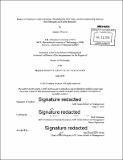Essays on employer credit screening, manufacturing skill gaps, and the relationship between skill demands and capital intensity
Author(s)
Weaver, Andrew, 1968-
DownloadFull printable version (8.148Mb)
Alternative title
Is credit status a good signal of productivity?
Skill demands and mismatch in U.S. manufacturing
Variation in manufacturing skill demands by industry-level capital intensity.
Other Contributors
Sloan School of Management.
Advisor
Paul Osterman.
Terms of use
Metadata
Show full item recordAbstract
This thesis consists of three essays that explore hiring criteria, skill demands and labor market outcomes. The first essay investigates the use of worker credit status as a hiring screen. The practice has sparked debate, with opponents asserting that it amounts to discrimination and proponents maintaining that it is an important tool for employers to assure the quality of new employees. This study uses a unique identification strategy along with credit proxy variables in a national dataset to test whether credit status reveals information about an employee's character that is predictive of employee productivity. The study finds that the character-related portion of credit status is not a significant predictor of worker productivity. The second essay addresses the question of whether U.S. manufacturers face a skill gap in hiring production workers. This study explores the issue by presenting and analyzing results from an original, nationally representative survey of U.S. manufacturing establishments that directly measures concrete employer skill demands and hiring experiences. The results indicate that demand for higher-level skills is generally modest, and that three quarters of manufacturing establishments do not show signs of hiring difficulties. Among the remainder, demands for higher-level math and reading skills are significant predictors of long-term vacancies, but, contrary to some theories of technical change, demands for computer skills and other critical thinking/ problem-solving skills are not. In terms of mechanisms, factors that complicate the interaction of supply and demand and that are associated with communication/coordination failures appear to play an important role. The third essay combines data from an original manufacturing skill survey with industry-level data on capital and equipment to explore the connection between capital intensity and current skill demands. The results indicate that contemporaneous capital intensity does predict higher level skill demands, but the effect is driven by higher-level reading skills rather than the math and computer skills that dominate the current debate. With regard to historical patterns, the study finds that the relationship between historical capital intensity and current skill demands changes over time, with increasing capital investment per worker showing opposite effects in the 1990s and 2000s.
Description
Thesis: Ph. D., Massachusetts Institute of Technology, Sloan School of Management, 2015. Cataloged from PDF version of thesis. Includes bibliographical references.
Date issued
2015Department
Sloan School of ManagementPublisher
Massachusetts Institute of Technology
Keywords
Sloan School of Management.